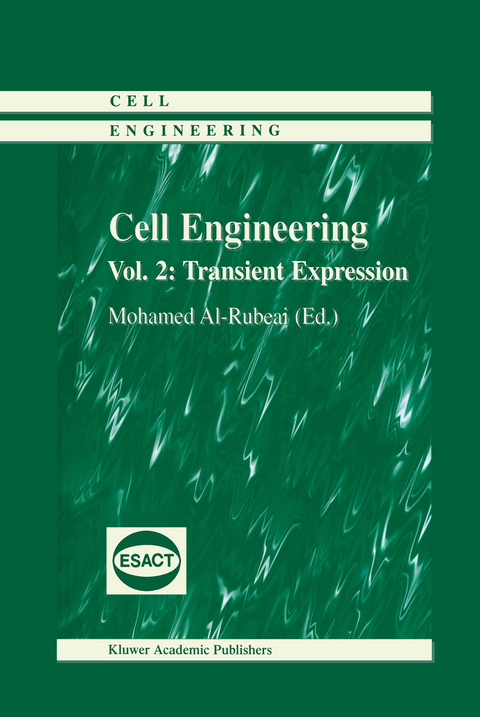
Cell Engineering
Transient Expression
Seiten
2012
|
Softcover reprint of the original 1st ed. 2000
Springer (Verlag)
978-94-010-5866-7 (ISBN)
Springer (Verlag)
978-94-010-5866-7 (ISBN)
The advantages of the baculovirus system are rooted in the properties of the virus and the host (insect, or cell lines derived from it). The budded virus rapidly spreads the infection from cell to cell within the insect host, resulting ultimately in the complete liquefaction of the host, and release of occluded virus into the environment.
The advantages of the baculovirus system are rooted in the properties of the virus and the host (insect, or cell lines derived from it). During the normal infection cycle, two forms of the virus are produced: an early budded virus (BY) form (Kost et al. , 2000), in which the viral DNA and structural proteins are surrounded by membrane derived from the infected cell; and a late occluded form (occlusion-derived virus, ODy), consisting of enveloped viral cores which are embedded in a crystal matrix of viral proteins. The principal component of the matrix is the abundantly expressed protein polyhedrin. The budded virus rapidly spreads the infection from cell to cell within the insect host, resulting ultimately in the complete liquefaction of the host, and release of occluded virus into the environment. The occluded form protects the released virus, allowing it to survive for long periods in the environment until ingested by another host. In the alkaline environment ofthe insect gut, the protective protein matrix is removed, and the life cycle is repeated. In insect cell cultures, only the BV form of baculovirus is required, and the polyhedrin gene may be replaced with the gene for the recombinant protein. An additional benefit of replacing or deleting polyhedrin is that it effectively makes the virus unable to survive outside the laboratory, an advantage in terms of environmental safety. The system is intrinsically safe to animals, being unable to replicate in species other than a limited range of insects.
The advantages of the baculovirus system are rooted in the properties of the virus and the host (insect, or cell lines derived from it). During the normal infection cycle, two forms of the virus are produced: an early budded virus (BY) form (Kost et al. , 2000), in which the viral DNA and structural proteins are surrounded by membrane derived from the infected cell; and a late occluded form (occlusion-derived virus, ODy), consisting of enveloped viral cores which are embedded in a crystal matrix of viral proteins. The principal component of the matrix is the abundantly expressed protein polyhedrin. The budded virus rapidly spreads the infection from cell to cell within the insect host, resulting ultimately in the complete liquefaction of the host, and release of occluded virus into the environment. The occluded form protects the released virus, allowing it to survive for long periods in the environment until ingested by another host. In the alkaline environment ofthe insect gut, the protective protein matrix is removed, and the life cycle is repeated. In insect cell cultures, only the BV form of baculovirus is required, and the polyhedrin gene may be replaced with the gene for the recombinant protein. An additional benefit of replacing or deleting polyhedrin is that it effectively makes the virus unable to survive outside the laboratory, an advantage in terms of environmental safety. The system is intrinsically safe to animals, being unable to replicate in species other than a limited range of insects.
Application of Recombinant Baculoviruses in Biopharmaceutical Research.- Engineering Post-Translational Processing of Recombinant Proteins Produced in Insect Cell Culture.- A Guide to Successful Scale-up of the Baculovirus Expression System.- Transient Gene Expression In Mammalian Cells Based on the Calcium Phosphate Transfection Method.- Adenovirus Vectors in Functional Genomics.- Adeno-Associated Virus: A Promising Tool For Gene Delivery.- Alphavirus Vectors: Highly Efficient Systems for Transient Gene Expression.- Transient Expression in Mammalian Cells: Applications and Perspectives.
| Reihe/Serie | Cell Engineering ; 2 |
|---|---|
| Zusatzinfo | VII, 223 p. |
| Verlagsort | Dordrecht |
| Sprache | englisch |
| Maße | 160 x 240 mm |
| Themenwelt | Medizin / Pharmazie ► Medizinische Fachgebiete ► Mikrobiologie / Infektologie / Reisemedizin |
| Naturwissenschaften ► Biologie ► Biochemie | |
| Naturwissenschaften ► Biologie ► Genetik / Molekularbiologie | |
| Naturwissenschaften ► Biologie ► Mikrobiologie / Immunologie | |
| Naturwissenschaften ► Biologie ► Zellbiologie | |
| Naturwissenschaften ► Biologie ► Zoologie | |
| Technik ► Umwelttechnik / Biotechnologie | |
| ISBN-10 | 94-010-5866-0 / 9401058660 |
| ISBN-13 | 978-94-010-5866-7 / 9789401058667 |
| Zustand | Neuware |
| Haben Sie eine Frage zum Produkt? |
Mehr entdecken
aus dem Bereich
aus dem Bereich
und Erste Hilfe an Bord
Buch | Softcover (2024)
MWV Medizinisch Wissenschaftliche Verlagsgesellschaft
CHF 55,90


